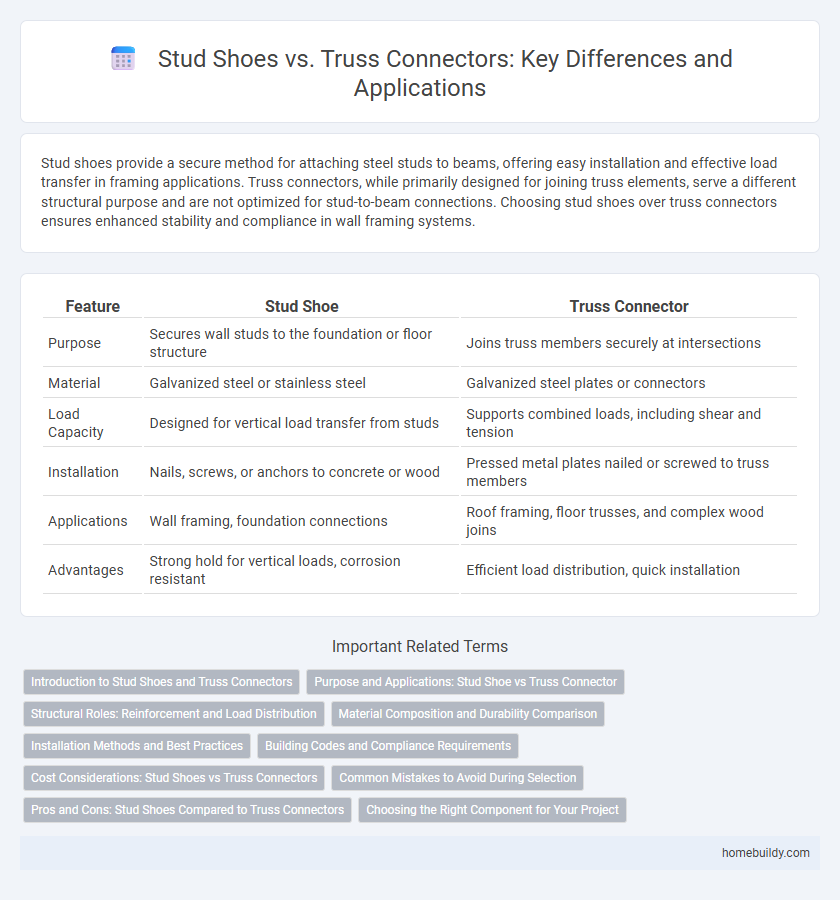Stud shoes provide a secure method for attaching steel studs to beams, offering easy installation and effective load transfer in framing applications. Truss connectors, while primarily designed for joining truss elements, serve a different structural purpose and are not optimized for stud-to-beam connections. Choosing stud shoes over truss connectors ensures enhanced stability and compliance in wall framing systems.
Table of Comparison
| Feature | Stud Shoe | Truss Connector |
|---|---|---|
| Purpose | Secures wall studs to the foundation or floor structure | Joins truss members securely at intersections |
| Material | Galvanized steel or stainless steel | Galvanized steel plates or connectors |
| Load Capacity | Designed for vertical load transfer from studs | Supports combined loads, including shear and tension |
| Installation | Nails, screws, or anchors to concrete or wood | Pressed metal plates nailed or screwed to truss members |
| Applications | Wall framing, foundation connections | Roof framing, floor trusses, and complex wood joins |
| Advantages | Strong hold for vertical loads, corrosion resistant | Efficient load distribution, quick installation |
Introduction to Stud Shoes and Truss Connectors
Stud shoes provide a secure base for attaching vertical studs to concrete or steel surfaces, enhancing load distribution and structural stability in framing systems. Truss connectors, designed for joining roof truss components, facilitate efficient load transfer and support complex roof designs. Both components are critical in construction, with stud shoes focusing on vertical fastening and truss connectors optimizing truss element connections.
Purpose and Applications: Stud Shoe vs Truss Connector
Stud shoes provide secure anchoring points for wood or metal studs in framing, primarily ensuring stability in wall construction and load distribution. Truss connectors are engineered to join truss members, optimizing structural integrity in roof systems by resisting tension and shear forces. While stud shoes focus on vertical load transfer and alignment in wall assemblies, truss connectors are specialized for complex joint reinforcement within roof trusses.
Structural Roles: Reinforcement and Load Distribution
Stud shoes primarily reinforce vertical steel studs by providing a stable base connection that enhances load transfer to the foundation, ensuring structural stability under compression forces. Truss connectors distribute loads across multiple truss members, optimizing weight distribution and improving resistance to lateral forces, which is essential in roof or floor systems. While stud shoes focus on reinforcing individual studs, truss connectors manage load pathways in complex framing assemblies for overall structural integrity.
Material Composition and Durability Comparison
Stud shoes are typically manufactured from galvanized steel, providing high resistance to corrosion and mechanical stress, ideal for securing wooden studs in construction. Truss connectors, also made from galvanized or stainless steel, often include thicker gauges and reinforced designs, enhancing load-bearing capacity and longevity under heavy structural loads. Both components excel in durability, but truss connectors generally surpass stud shoes in strength due to their robust material composition and specialized engineering for roof trusses.
Installation Methods and Best Practices
Stud shoes are typically installed by securing the shoe around the base of the steel stud, providing a solid anchor point, while truss connectors are attached with screws or nails to connect truss components effectively. Best practices for stud shoe installation include ensuring proper alignment with the stud and using corrosion-resistant fasteners to maintain structural integrity. Truss connector installation requires precise placement according to engineering specifications and using manufacturer-recommended fasteners to ensure load transfer and safety.
Building Codes and Compliance Requirements
Stud shoes and truss connectors both play crucial roles in structural framing, each subject to stringent building codes such as the International Building Code (IBC) and American Wood Council (AWC) standards. Stud shoes must comply with specific load-bearing capacity requirements and fire resistance ratings to ensure wall stability and safety in multi-story constructions. Truss connectors are regulated for precise tension and shear values, meeting standards like ASTM D7147, to guarantee roof and floor system integrity under various stress conditions.
Cost Considerations: Stud Shoes vs Truss Connectors
Stud shoes generally offer a cost-effective solution compared to truss connectors, primarily due to their simpler design and easier installation process, reducing labor expenses. While truss connectors provide enhanced structural support, their higher material complexity and installation requirements often result in increased overall costs. Evaluating project budgets should balance cost savings from stud shoes against the long-term benefits and potential additional expenses linked to truss connectors.
Common Mistakes to Avoid During Selection
Selecting a stud shoe instead of a truss connector can lead to improper load distribution, compromising structural integrity. Common mistakes include ignoring load capacity specifications and failing to match the connector type to the wood species or environmental conditions. Ensuring precise compatibility with design requirements and consulting manufacturer guidelines prevents costly errors and ensures optimal performance.
Pros and Cons: Stud Shoes Compared to Truss Connectors
Stud shoes provide robust support for wood studs by securely anchoring them to concrete or masonry, offering excellent load-bearing capacity and resistance to lateral forces. Truss connectors, designed primarily for joining wood trusses, simplify assembly and improve alignment but may lack the same level of individual stud reinforcement found in stud shoes. While stud shoes excel in traditional framing applications with direct concrete contact, truss connectors offer faster installation and flexibility in roof or floor truss systems but require careful consideration of load distribution and environmental exposure.
Choosing the Right Component for Your Project
Stud shoes provide superior lateral load resistance and are ideal for securing vertical studs to concrete or steel foundations, ensuring structural stability. Truss connectors, designed primarily for fastening truss elements, offer flexibility in roof framing but may lack the robust shear capacity required in heavy load-bearing walls. Selecting stud shoes over truss connectors enhances durability in high-stress applications, optimizing safety and compliance with building codes.
stud shoe vs truss connector Infographic

 homebuildy.com
homebuildy.com